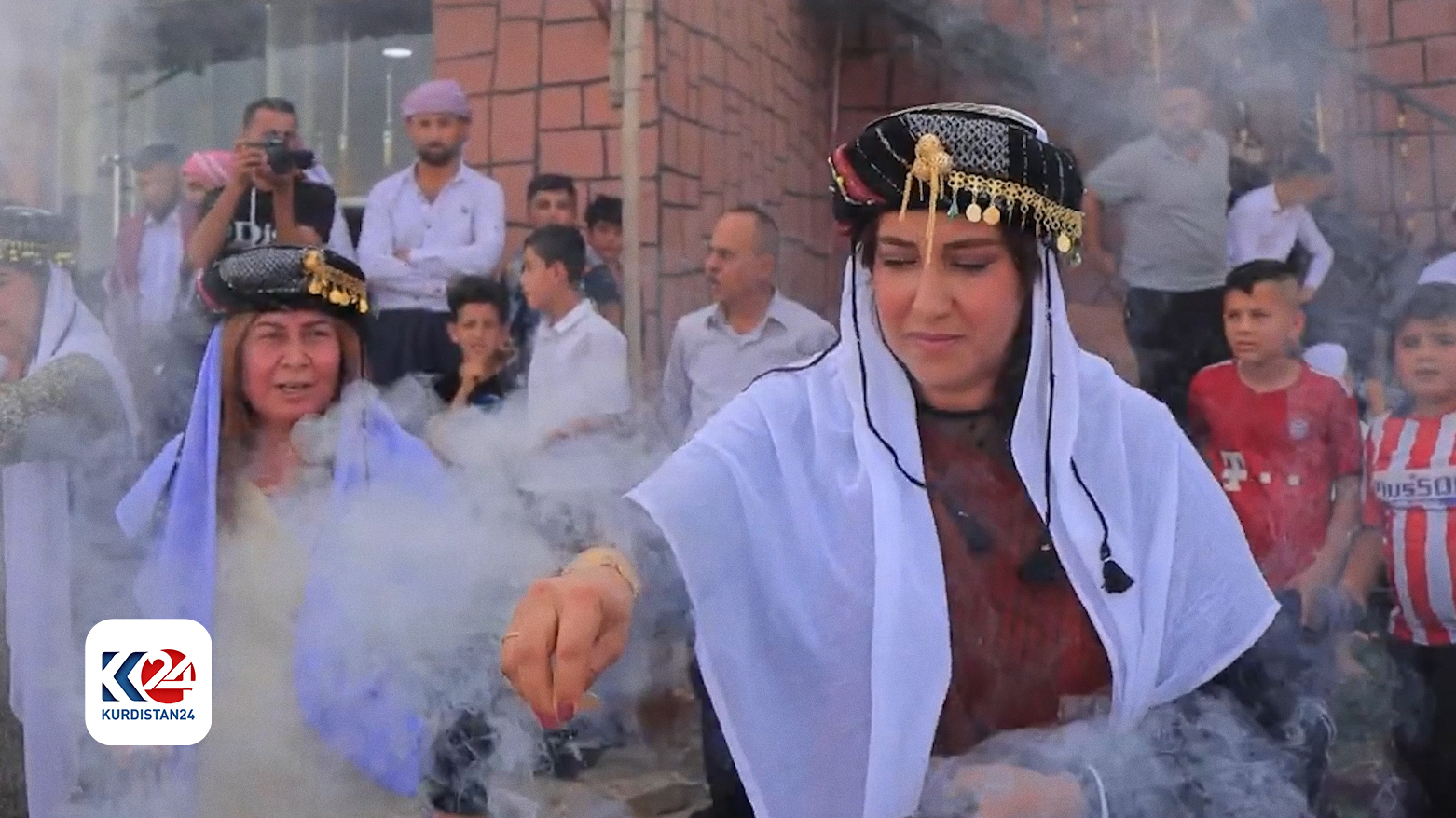The Sacred Journey of Tawus Tour: Reviving Ancient Yezidi Traditions
This cherished tradition not only fortifies social bonds among the Yezidi Kurds but also rekindles the rich tapestry of their cultural and religious heritage.

ERBIL (Kurdistan24) – The annual Tawus Tour, known locally as "Gara Tawus," has once again embarked on its revered journey through the villages and communities of the Yezidis in Duhok province, culminating in the district of Ba’adre.
This cherished tradition not only fortifies social bonds among the Yezidi Kurds but also rekindles the rich tapestry of their cultural and religious heritage.

In Ba'adre subdistrict, part of the Sheikhan district, residents adorned in traditional white Yezidi clothing warmly welcomed the peacock symbol with pans, incense, tambourines, and religious music.
Khalid Narmo, an intellectual in the Ba'adre district, highlighted the significance of this event, noting that the "Gara Tawus" travels through all villages and communities in Duhok province and the Nineveh plain, with Ba’adre as its final stop.
He emphasized that this religious tradition, dating back over 1,000 years, has been pivotal in fostering social reconciliation within the Yezidi community.
A Symbol of Unity and Peace
The Tawus Tour is not merely a religious ceremony; it represents a convergence of villagers and their relatives, fostering a spirit of mutual acceptance and tolerance.
Daye Fato expressed joy over the return of the Tawus, remarking, “We were very happy with the arrival of the Tawus because it had not come for several years. When Tawus goes to each village, everyone gathers in a house in the evening and eats dinner.”

This biannual tradition is deeply embedded in Yezidi culture, where a copper Tawus, symbolizing a peacock, is revered as a sacred symbol.
According to Yezidi belief, God sent Angel Tawus to enrich the Earth with colors, making Tawus a holy emblem.
The Tawus Tour serves a dual purpose: interpreting religious texts and offering guidance while addressing social issues within the community.
Historical Significance and Sacred Rituals
The history of the Tawus Tour is marked by resilience.
During the Ottoman Empire’s rule over Mosul, Yezidis possessed seven Tawuses. However, a genocidal campaign in 1892 led to the loss of several sacred objects, including Tawuses.
Today, only three of the original seven Tawuses remain, each embarking on distinct tours across various regions.
These include the “Tawus of Anzal,” the “Tawus of Sinjar,” and the “Tawus of Halab (Aleppo Tawus),” covering areas in Iraq and Syria.
Falah Haider Kheder, a devoted Yezidi, elaborated on the intricacies of the Tawus Tour, explaining the roles of various religious figures and the meticulous rituals involved.
Out of the three Tawuses that were recovered, one is recognized as the “Tawus of Anzal”. This Tawus embarks on tours to Yezidi towns and villages in Sheikhan, Tel Kef, Duhok, Bashiqa, and Bahzani.
The second one is called the “Tawus of Sinjar”, and tours to Sinjar and Yezidi places in Sinjar, Haweri (Ezidi tribe) villages and towns around Zakho.
The third is called Tawus of Halab (Aleppo Tawus) and tours to Yezidi places in Syria.
The remaining four non-returned Tawuses are still missing.
Among these missing Tawuses, one was “Tawus of Masquf” and it used to be toured to Yezidi places in Georgia, Armenia and Russia.
The other one was the “Tawus of Zozana” toured in Hakare in Southern Turkey and north-most parts of the Kurdistan Region.
The other two Tawuses were the “Tawus of Khalta”, which toured inhabited places within Khalta tribe in Turkey, and the “Tawus of Tabreze”, which toured Yezidi areas in Tabriz, north west of Iran.
The tour commences in Lalish, where the Tawus is purified using water from the White Spring. Accompanied by tambourine and flute music, and the recitation of religious texts, the Tawus is then taken to Tawus Valley in Bahzani, marking the beginning of its journey.
A Community Affair
Each village eagerly anticipates the arrival of the Tawus.





A family is selected to host the sacred symbol, and residents, dressed in clean white clothes, gather to welcome it.
The Qawals, religious leaders, play tambourines and flutes as villagers approach to kiss the Tawus, make wishes, and offer prayers.
The ceremony involves communal meals, religious recitations, and social guidance, often resolving local issues.
Falah Haider Kheder explained the roles of Qawals and Faqirs during the tour.
The Qawals lead the procession, recite religious texts, and offer guidance. Faqirs provide blessings and serve Sherbik water, while ensuring that each family receives candles from the White Spring.
This ritual is followed by the religious dance, Govand, where participants receive blessings.
Sherbik is blessed water from the White Spring, served to people by Qawals.
Barat is sacred round object made of holy soil from Lalish, symbolizing Earth’s blessings.
Govand is a revered religious dance where people participate to receive blessings.
The Tawus Tour is a profound expression of Yezidi faith and culture, emphasizing the importance of unity, guidance, and social harmony.
As it travels through the Yezidi villages, it not only preserves ancient traditions but also strengthens the communal bonds that are the cornerstone of Yezidi society.
